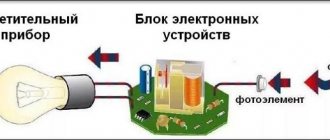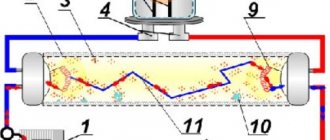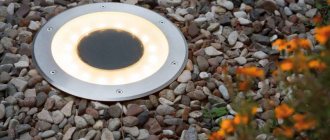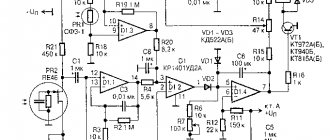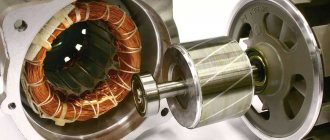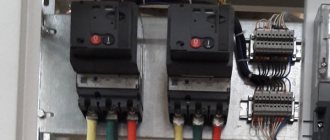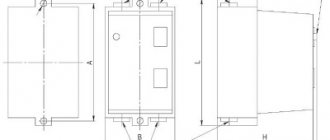Growing demands on modern lighting systems force consumers to look for new technical means to provide such an important function. Some time ago, a transitional stage took place from classic incandescent lamps to mercury and sodium devices. Such devices are still used today in different versions, but their operation is accompanied by significant disadvantages. In particular, mercury lamps have serious restrictions on their use and high requirements for the technical organization of the installation with further maintenance due to the toxicity of the working environment. Sodium models, in turn, are characterized by a skew in the color spectrum of the glow. The induction lamp does not have the two indicated disadvantages, which can easily replace both full-fledged mercury models and sodium-based devices.
Installation of induction lamps
Despite many differences in the immediate operating process, induction devices still belong to the segment of common gas-discharge lamps. The main feature of such lamps is the absence of electrodes. However, this difference is also conditional. The basis of the design is also a flask that contains plasma - it acts as a generator of light energy. In addition, induction lamps are complemented by a gas cylinder, which is located next to the magnetic coil. Such devices are called electrodeless for the reason that direct contact of the working element with the gaseous environment is not provided. Also, the absence of classic metal electrodes inside the cylinder increases the service life of the device. As practice shows, lamps of this type are not recycled until the phosphor resource is used up. This corresponds to approximately 100,000 operating hours of the device.
Operating principle of models with an external generator
All induction lamps work in conjunction with a generator in one way or another. The most common devices are those that are operated with the connection of an external electronic device that generates current at a high frequency. Energy flows through the winding of the coil, which is equipped with an induction lamp, after which the lamp lights up. Gas atoms, excited by electricity, fill the lamp cavity, emitting photons with waves whose length corresponds to the particles of the plasma filling the lamp.
Typically, such lamps contain mixtures including argon and mercury. The first gas is added precisely to simplify ignition at a low temperature. This function is appropriate if the mercury pressure is not enough to generate a discharge that activates induction lamps. The operating principle of such devices is in many ways similar to luminescent devices for the reason that in both cases the possibility of a phosphor is assumed, which ensures the formation of ultraviolet radiation.
Historical information
In the 60s of the last century, conventional incandescent lamps began to be replaced by mercury arc lamps. This is an ordinary luminescent device that works on the principle of accelerating mercury atoms in an inert gas between two electrodes. The flask, where all the work takes place, is coated inside with a phosphor. When moving, mercury atoms hit it and converted kinetic energy into light photons. This is how all induction lighting works.
In the 90s, LED lamps became widely used, then they were replaced by electrodynamic lamps. Modern devices do not use mercury. Instead, a special alloy is used, including copper, silver or gold. The composition is called amalgam, it is safer for human health than pure mercury. In terms of light output, the lamps are not inferior to other models, and their price is significantly lower.
Features of devices with an integrated generator
Lamps operating from an external separate generator are often not supplemented with a phosphor coating. For this reason, they scatter only the light produced by the ionized gaseous plasma. According to the general classification, such models can be classified as gas-light lamps. By the way, street induction lamps are often made exactly according to this principle - with an external location of the electric generator. This is due to the long service life and increased reliability of such devices - accordingly, they are more resistant to damage and other external influences.
Main characteristics
One of the main characteristics of lighting devices is light output. In this case, the nominal value is about 80 lm/W. Manufacturers also, in some versions, strive to increase the power of lamps, but this affects the reduction of the working life of the devices. By the way, according to manufacturers, the average operating range varies from 80 to 100 thousand hours. In recent years, users themselves have increasingly paid attention to the time delays for turning on and off lighting devices. In this regard, the induction lamp has an advantage even in the environment of gas-discharge analogues. Thus, the time for the lamp to completely cool down after a power outage is only 5 minutes. As for color rendering, induction models correspond in this characteristic to mercury lamps, since they contain almost the same filler.
Industrial energy-saving lamps, as the category of the most energy-intensive light sources
In this article we will try to consider issues related to the implementation of industrial energy-saving lamps, since in our opinion this type of light source is one of the most energy-intensive. The first experiments in creating inexpensive LED lamps began with the creation of LED lamps assembled from lamp housings of the RKU ZHKU type and LED blocks installed in them. As practical experience has shown, it is possible to install small power LEDs or clusters based on them in the above types of cases, since the above option for choosing a case does not provide the required heat sink for LED boards. This path to creating inexpensive LED lamps has been followed by many companies; similar solutions for low-power LED lamps can still be found today. Attempts to create a model similar in light characteristics to a luminaire with a DRL 250 lamp based on stamped steel housings were basically doomed to failure. In such solutions, the LEDs overheat after a short period of time and begin to change color, which means that the service life of such “crafts” is significantly lower than the claimed 50,000 hours.
Having developed a large client base, as well as analyzing a huge number of requests to our company on energy saving issues, it became clear that industrial enterprises are most in need of savings. This is understandable; as a rule, the installation height of industrial lamps exceeds 5-6 meters, and sometimes reaches 12-15 meters. The operating mode of lighting systems in many enterprises is 12 or 24 hours. In these conditions, the issue of energy saving is especially acute. What light source should replace DRL, DNAT or MGL lamps?
Below is a comparison table of some types of lamps
| Lamp type | Average service life (burning hours) | Device efficiency | Efficiency (Lm/W) | Decrease in luminous flux towards the end of lamp life | Operating temperature | Guarantee period | Maintenance during operation 5 years |
| Induction | 100000 | 0.98 | 80-110 | 10-15% | -42…+50 | 5-10 years | Technological cleaning |
| Incandescent | 1000 | 0.1 | 41794 | 40-60% | -50…+70 | No | Replacing lamps |
| High pressure mercury | 4000 | 0.85 | 20-24 | 40-60% | -40…+40 | No | Replacing lamps and ballasts |
| Luminescent | 8000 | 0.85 | 26-29 | 40-50% | +10…+40 | No | Replacing lamps and ballasts |
| CFL | 8000 | 0,5-0,85 | 18-22 | 15-30% | -20…+40 | 3 months | Replacing lamps |
| High pressure sodium | 2000 | 0.85 | 42-50 | 40-60% | -20…+40 | No | Replacing lamps and ballasts |
| Metal halide | 8000 | 0,65-0,8 | 24-36 | 15-20% | -20…+40 | Special conditions | Replacing lamps and ballasts |
| LED | 50000 | 0.93 | 95-123 | 20-30% | -45…+60 | 3-5 years | Technological cleaning |
It is clear that over the past couple of years the market for industrial energy-efficient lighting has grown significantly, and it is developing in both intensive and extensive ways. With the growing number of proposals, lamp models appeared that were clearly created by amateurs who were far from understanding the physical processes in semiconductor light sources. But we must pay tribute that some manufacturers have achieved clear success in developing designs and power supplies for LED lamps, as well as creating models with specified luminous flux parameters. If we analyze the market for LED lamps presented by different manufacturers, the product range is most widely represented by powers from 6-15 W to 40-60 W (luminous flux of lamps up to 5-6 thousand lumens). These are light sources for housing and communal services, multiple modifications of lamps for Armstrong-type ceilings, street lighting from low heights, etc. After this “power” milestone, the number of models decreases significantly.
This is due to the fact that the production of LED lamps with a power of 120-150 W and above requires special calculations to ensure the creation of the necessary geometry of the lamp body for optimal functioning of the LEDs. We can confidently conclude that the design of a powerful LED lamp, made taking into account all the requirements for heat dissipation, optimal driver characteristics, is a complex technical product. It is this category that includes light sources for lighting workshops, terminal warehouses, etc.
Industrial energy-saving lamps based on induction lamps differ significantly in structure and requirements for heat dissipation. Thus, the heating temperature of the lamp does not exceed 80-85 degrees Celsius and this parameter only indirectly affects the physical processes of light production. It is also important to note one fundamental point that distinguishes industrial LED lamps from induction lamps. If the first one fails, to repair it it is necessary to dismantle the equipment and transfer it to a trading organization or to the manufacturer's plant. As a rule, in this case, repairs cannot be carried out at the installation site. This problem does not exist with induction light sources. It is enough to simply purchase either the lamp itself or the ballast (ballast) for it. A failed light source can be replaced by any enterprise electrician without special training. In addition, the warranty for most LED lamps does not exceed three years versus five years for induction lamps or a lamp based on them.
An important factor in favor of creating energy-saving lighting systems based on induction lamps is the ability to use already installed pendant lamp housings. Using special adapters for E40 or E27 sockets, it is possible to install lamps in traditional RSP (ZhSP) housings. This function allows you to significantly reduce the customer’s costs when converting the existing lighting system to energy-saving induction lighting. So in May 2012, our company carried out a set of works to re-equip the lighting system of repair areas and showrooms at one official NISSAN dealer in Russia - NATCGROUP. More than 100 200 W induction lamps were installed in the installed aluminum and polycarbonate housings. Replacing the HPS and MGL lamps made it possible to make the colors of the cars displayed in the hall more saturated and bright, as well as to provide more comfortable light for the employees of the repair shops.
Induction lighting system for repair areas and showrooms at one official NISSAN dealer in Russia - NATCGROUP
Currently, work is underway to re-equip a number of industrial workshops at enterprises in the Moscow, Kursk and Belgorod regions.
Lighting system with induction lamps from NATCGROUP
Performance properties of induction lamps
Among the operational features, the ability of lamps to dim, that is, change the radiation intensity in a wide spectrum from 30 to 100%, stands out. This opportunity, by the way, expands the options of intelligent control systems that can be applied to the same street devices. This advantage leads to another distinctive feature. The combination of the device with automatic power control systems and an astronomical timer provides the ability to optimally configure the lamp in terms of energy savings. In addition, induction lamps provide an expanded range of color temperatures. The user can choose soft and natural radiation for a living space or cool lighting for outdoor systems. There is also the possibility of automatic configuration in some models.
Device marking
The shape and technical features of the lamps are indicated in their markings. The first two letters IL are the designation of the induction lamp, the third characterizes the shape, then the power is described. The minimum and maximum performance are 15 and 500 W, respectively, but there are also more efficient devices for industrial use. The luminaires can be used in devices with sockets of the E40, E27 and E14 series.
Manufacturers have released a line of phytolamps that differ in the shape and color of the stream. These models are designed to illuminate plants at different periods of their life and development. The series is designated by the abbreviation TIL, and the technical characteristics are indicated by two letters:
- FL - used at the initial stage of flowering, they emit a red luminous flux;
- GP and VG models - necessary during vegetative growth, emission color - blue;
- The unique CL series allows you to control the development of the plant; fruits and flowers quickly appear and ripen under the bright red light.
You may be interested in Features of replacing a light bulb in a suspended ceiling
If TIL series lamps were initially used to improve the growth of a flower or fruit bush, they are used throughout its entire life. But before buying, you need to understand the labeling. For example, TILPfl-100 is a rectangular phytodevice with a power of 100 W, designed to accelerate flowering. And ILK-60 is a round lamp with a capacity of 60 W.
Areas of application
The high stability of the operating parameters of gas-discharge lamps allows them to be used even in highly specialized fields - for example, in spectrometry, which requires the use of ultraviolet radiation. Induction-type devices are also used in pumping laser systems to excite gas. But most often such models are still used in more familiar conditions. For example, to provide indoor home and outdoor garden lighting. A separate niche is occupied by industrial induction lamps, which are characterized by high power and a longer service life. Such equipment is used to equip street communications, highway tunnels, industrial and warehouse facilities, stadiums and parking lots.
conclusions
To summarize, we can say that induction lamps are more suitable for lighting large indoor spaces or spacious open areas. The presence of electromagnetic and UV radiation accompanying the glow, the large dimensions of the flasks force us to limit their use for domestic needs. These are rather promising industrial lamps that can effectively perform their function at minimal cost to the owner. Installed on street sites or under high arches of industrial premises, they will not cause harm to workers. The most successful example of their application is the use of induction phyto-lamps for lighting greenhouses. Operating personnel are exposed to minimal radiation, and at the same time, the intensity of plant vegetation and their productivity increase significantly, and fertilizers are not needed.
How much does an induction lamp cost?
Technologically, the process of manufacturing induction lamps is quite complex and unsafe if all requirements for organizing production are not met. This determines the narrowness of the segment in which these products are sold, as well as the high cost at which induction lamps are sold. Prices in the initial class vary in the range of 4-5 thousand rubles. This level significantly exceeds the cost of LED models. Even in premium lines, LED lamps for household use are priced at 2-3 thousand rubles.
The price tags for specialized and industrial induction-type devices are also impressive. In particular, ITL induction lamps for outdoor use are available for an average of 10-15 thousand rubles.
Advantages and disadvantages
Like any other devices, induction lamps have their advantages and disadvantages. Among the advantages are:
- release of a clean and bright stream of light;
- high level of efficiency - up to 80−90 lm;
- efficiency - energy consumption is 80% lower than that of conventional incandescent lamps;
- quick start-up without any delays;
- lack of sensitivity to frequent use;
- Possibility of use together with a dimmer;
- significant service life and trouble-free operation - over 60,000 hours;
- minimal waste of brightness regardless of the age of the lamp.
The devices also have a wide power range - from 15 to 500 W for private use and above the maximum for industrial premises. Different models emit a colored glow - red, blue, white. During operation, the lamp body practically does not heat up.
The main disadvantages of the devices:
- release of toxic substances when the flask is damaged due to mercury vapor contained in it;
- The lamp must be disposed of after use;
- large body sizes are not suitable for conventional lampshades;
- electromagnetic radiation disrupts the operation of delicate electronic devices, so lamps are not installed in airports and premises where there are such devices;
- not suitable for rooms with low ceilings, since the source of ultraviolet radiation must rise above people’s heads by at least a meter;
- low strength of the flask.
